Glaucoma Medication Reminder Tracker
Set Up Your Medication Schedule
Enter your eye drop information to create a personalized tracking schedule.
Your Glaucoma Medication Schedule
Open-angle glaucoma is a chronic eye disease that gradually damages the optic nerve by allowing fluid to build up inside the eye, raising intraocular pressure. If left unchecked, the pressure can lead to irreversible vision loss. Most people manage the condition with prescription eye drops, which lower pressure and help preserve sight. This guide walks you through the basics of the disease, the different drop classes, how to use them correctly, and tips for staying on track.
Understanding Open-Angle Glaucoma
Open-angle glaucoma accounts for about 90% of glaucoma cases worldwide. The drainage angle in the eye stays open, but the trabecular meshwork becomes less efficient, causing fluid (aqueous humor) to accumulate. Because the disease progresses silently, many patients don’t notice any symptoms until peripheral vision is already compromised. Regular visual field tests and optic nerve imaging are the only ways to catch changes early.
Why Eye Drops Are First-Line Therapy
Topical drops act directly on the eye, offering rapid pressure reduction without the systemic side effects of oral meds. They’re easy to prescribe, adjust, and combine, making them the go‑to choice for most ophthalmologists. In many cases, a single drop class can keep pressure within the target range (< 21 mmHg), but some patients need a cocktail of two or three types.
Main Classes of Glaucoma Eye Drops
Below is a quick rundown of the four most common families. Each works in a different way, so your doctor may mix and match to hit the sweet spot.
| Class | Mechanism | Typical Dose | Common Side Effects | Frequency |
|---|---|---|---|---|
| Prostaglandin analogs | Increase outflow through uveoscleral pathway | 0.005%-0.03% (0.5‑1 drop) | Darkening of iris, eyelash growth, mild eye redness | Once daily |
| Beta blockers | Reduce aqueous humor production | 0.25%-0.5% (1 drop) | Temporary blurred vision, dry eye, rare systemic effects (low heart rate) | Twice daily |
| Carbonic anhydrase inhibitors | Block enzyme that produces aqueous humor | 0.5%-2% (1 drop) | Taste disturbances, mild burning, occasional sulfa allergy reaction | Twice daily |
| Alpha agonists | Both reduce production and increase outflow | 0.1%-0.5% (1 drop) | Dry mouth, fatigue, occasional conjunctival hyperemia | Twice daily |
Newer options like Rho kinase inhibitors are entering the market, offering additional mechanisms for patients who need more pressure control.
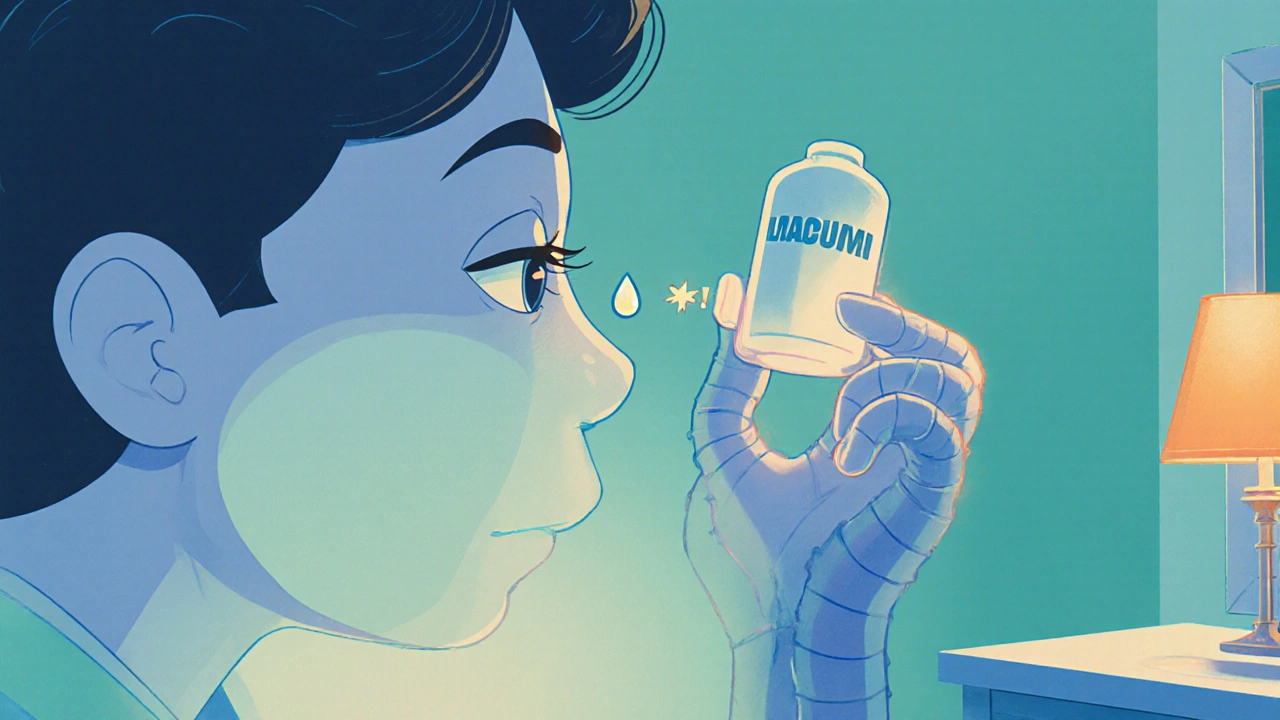
How to Use Eye Drops Correctly
- Wash your hands thoroughly with soap and water.
- Shake the bottle if the label says to do so (most prostaglandin analogs need a gentle shake).
- Tilt your head back slightly and pull down the lower eyelid to create a small pocket.
- Hold the bottle upside down, press gently, and let one drop fall into the pocket. Do not touch the tip to the eye or lashes.
- Close your eye gently for about 1 minute. Press the inner corner of the eye (near the nose) with a finger to block the tear duct-this helps keep the medication from draining away.
- If you need more than one type of drop, wait at least 5 minutes between each bottle. This prevents dilution.
- Replace the cap securely and store the bottle as directed (usually in a cool, dry place, no refrigeration unless the label says otherwise).
Practice the technique a few times in front of a mirror; muscle memory makes it faster and reduces missed doses.
Managing Side Effects and Adherence
Many patients stop using drops because of irritation or inconvenience. Here are practical fixes:
- Redness or burning: Use preservative‑free formulations if you’re sensitive. A cool compress after dosing can soothe the eye.
- Darkening of the iris: This is harmless but permanent. Discuss alternatives if the change concerns you.
- Dry eye: Pair drops with artificial tears (prescribed at a different time of day). Avoid eye makeup right after dosing.
- Forgotten doses: Set a daily alarm on your phone, or keep the bottle next to your toothbrush or bedtime routine.
Regular follow‑up appointments-usually every 3‑6 months-let your doctor adjust the regimen before pressure spikes cause damage.
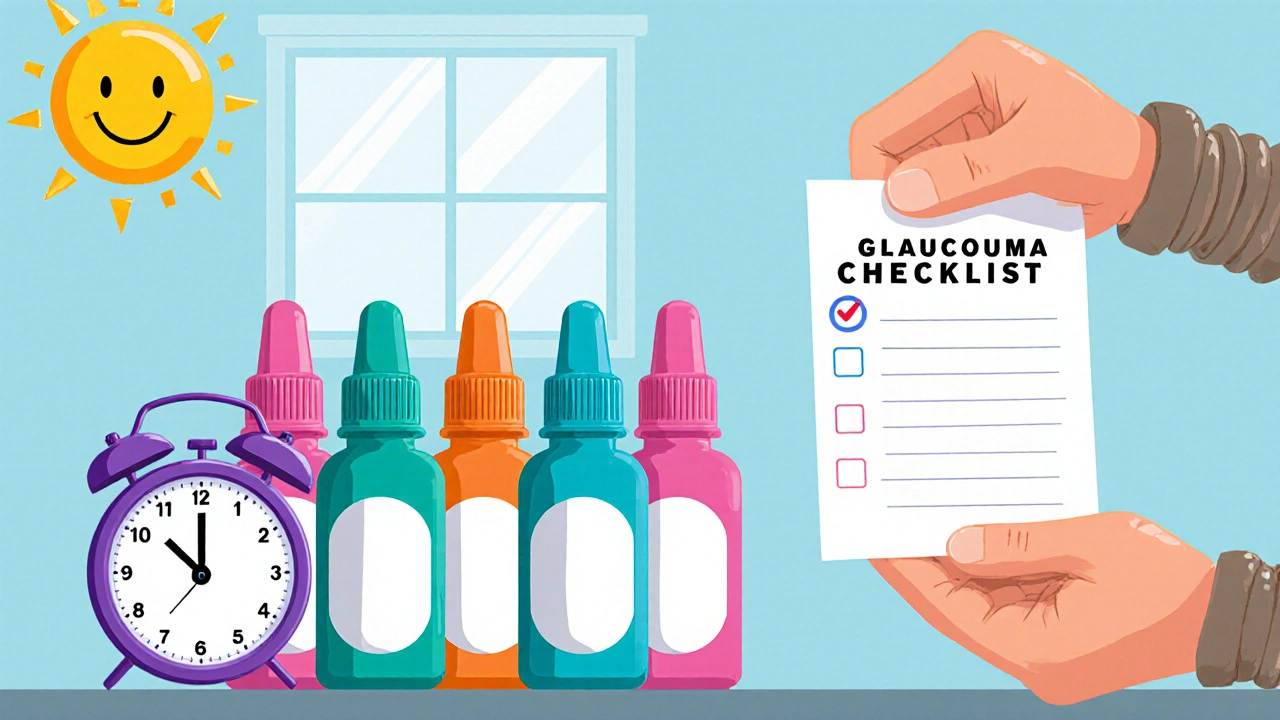
Checklist for Medication Management
- Have a written list of all eye drops, including brand name, strength, and dosing schedule.
- Mark each bottle with the time of day you should use it (e.g., “Morning - Latanoprost”).
- Keep a simple log (paper or app) to record each dose; check it nightly.
- Store spare bottles in a place that’s easy to reach but out of children’s reach.
- Schedule a reminder for prescription refills-most pharmacies can send a text when supplies run low.
- Bring your medication list to every eye‑doctor visit, even if you think nothing has changed.
Frequently Asked Questions
Can I use over‑the‑counter eye drops instead of prescription ones?
Over‑the‑counter drops are meant for temporary irritation and do not lower intraocular pressure. They won’t protect the optic nerve, so they can’t replace prescription medication.
What if I miss a dose?
Take the missed drop as soon as you remember-unless it’s almost time for the next scheduled dose. In that case, skip the missed one and resume your regular schedule. Never double‑dose.
Do eye drops affect my ability to drive?
Most drops cause only temporary blur for a few minutes. Wait until your vision clears before getting behind the wheel.
Are there preservative‑free options?
Yes. Many brands offer preservative‑free single‑use vials, which are ideal for people with dry eyes or allergies.
How often should I see my eye doctor?
Typically every 3‑6 months, but your doctor may adjust the interval based on pressure control and disease progression.

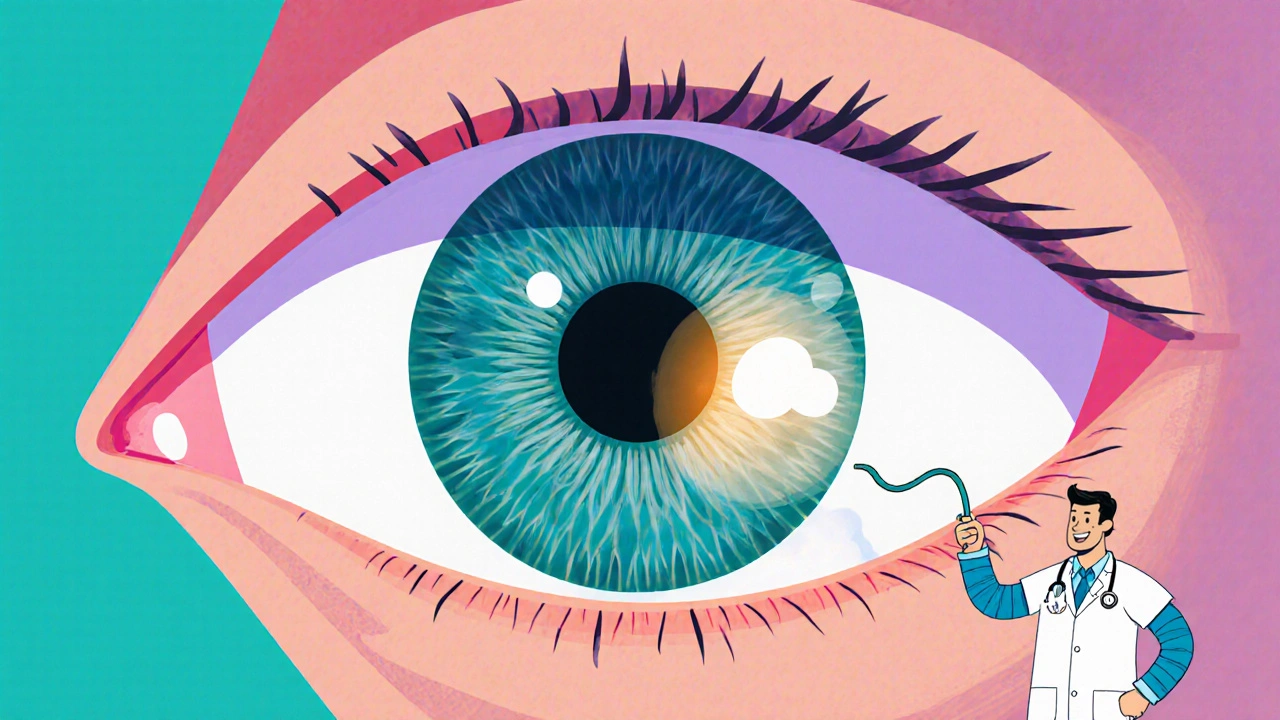


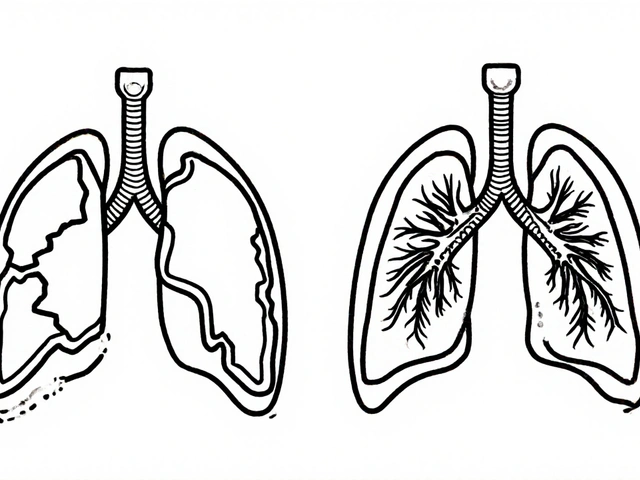
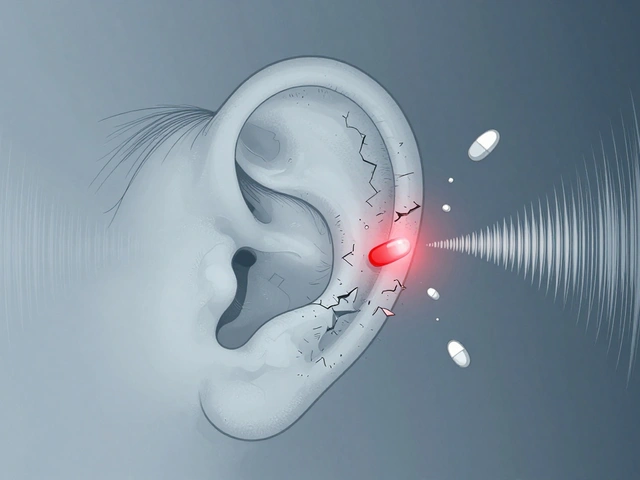
Nickolas Mark Ewald
Thanks for putting together a clear rundown of the eye‑drop options. The table makes it easy to compare mechanisms and side effects at a glance. I appreciate the step‑by‑step guide on how to actually administer the drops – the tip about pressing the inner corner is especially helpful. Setting a reminder on my phone has saved me from missing doses more than once. Overall a solid reference for anyone new to glaucoma management.
Chris Beck
Seriously? This "clear" guide leaves out the cost issue – most patients can’t afford multiple branded drops!! You’d think a simple article would at least mention generic alternatives. Also, the advice to “store in a cool, dry place” ignores the reality of cramped bathrooms. Stop sugar‑coating the problem.
Emily Rankin
Reading this guide felt like stepping onto a quiet forest path where each step reveals a hidden truth about our sight. The gentle reminder to wash hands before touching the eye echoes a ritual of respect for the body’s delicate windows. Imagine the future where a simple drop shields the world from fading into darkness – that vision fuels hope. The checklist, with its humble bullet points, reads like a promise we make to ourselves: stay vigilant, stay alive. In moments of frustration, recall the “press the inner corner” trick; it’s a small act of defiance against a relentless disease. Let us celebrate each dose taken, each field of peripheral vision preserved, as a quiet victory over entropy. The guidance here is not just medical; it is a narrative of perseverance, a testament to human resilience.
Roberta Makaravage
Honestly, if you don’t follow the exact protocol you’re basically courting blindness 🙄. Stick to the schedule, use preservative‑free options if you’re sensitive, and don’t blame the drops for your own negligence 😏.
Lauren Sproule
Hey guys, this post is super helpful!! i love the little checklist thingy, makes me feel organized. i just wish they’d add a reminder app link lol.
CHIRAG AGARWAL
Dude, you’re onto something – I actually set my phone alarm for the drops and it’s like my personal hype man. Plus, I keep a spare bottle in the kitchen, next to the coffee, so I never miss a beat. If you wanna share the app, I’m all ears, bro.
genevieve gaudet
Y’all see this as just a list, but it’s a cultural ritual of caring for the windows to our soul. in many traditions, eye health is linked to spiritual clarity, so the routine becomes a meditation. don’t forget to breathe deep while you wait for the drop to settle.
Miriam Rahel
First and foremost, the presented guide demonstrates a commendable effort to synthesize current pharmacological strategies for open‑angle glaucoma. It systematically enumerates the principal classes of ocular hypotensive agents, thereby affording the practitioner a concise reference. The inclusion of a comparative table is particularly advantageous, as it juxtaposes mechanism of action, dosing frequency, and adverse effect profile in a format conducive to rapid assimilation. Moreover, the procedural instructions for instillation are articulated with sufficient granularity to mitigate common errors, such as conjunctival contamination. The recommendation to occlude the nasolacrimal duct post‑administration is consistent with evidence indicating reduced systemic absorption of preserved formulations. Nonetheless, the guide would benefit from an explicit discussion of cost considerations, especially given the escalating expense of branded prostaglandin analogues. A brief analysis of generic equivalents and potential insurance barriers could enhance its pragmatic utility. Furthermore, while the checklist is a useful tool, its efficacy may be amplified through integration with digital adherence monitoring platforms, an innovation that warrants mention. The brief exposition on preservative‑free options is appreciated, yet a more thorough appraisal of sulfonamide hypersensitivity risks associated with carbonic anhydrase inhibitors would be prudent. In addition, the guide omits emerging data on fixed‑combination products that consolidate therapeutic regimens and may improve compliance. The advisory regarding the interval between multiple drops is accurate, but the cited interval of five minutes might be overly conservative in certain clinical scenarios. Finally, the FAQ section, though succinct, could be expanded to address patient‑specific concerns such as pregnancy considerations and postoperative management following laser trabeculoplasty. In summary, the document constitutes a solid foundation for patient education, albeit with opportunities for refinement that would elevate it to a comprehensive resource. Future revisions should contemplate a dedicated section on lifestyle modifications, such as aerobic exercise, which have demonstrated modest IOP reduction. Incorporating patient testimonials could also personalize the guide and foster greater adherence.
Joanna Mensch
All that sounds official, but have you considered that the pharma industry might be hiding cheaper natural alternatives from us?
RJ Samuel
Honestly, I think the whole “drop” craze is just a placebo gimmick.
Patricia Echegaray
Look, the truth is that the “official” guidelines are written by people who get paid to keep us buying brand‑name bottles – it’s a deliberate scheme to control our vision and our wallets. You’re right to doubt the narrative, but don’t forget that alternative “natural” cures are often just untested snake‑oil. Stay vigilant, question every label, and protect your eyes from both disease and corporate greed.